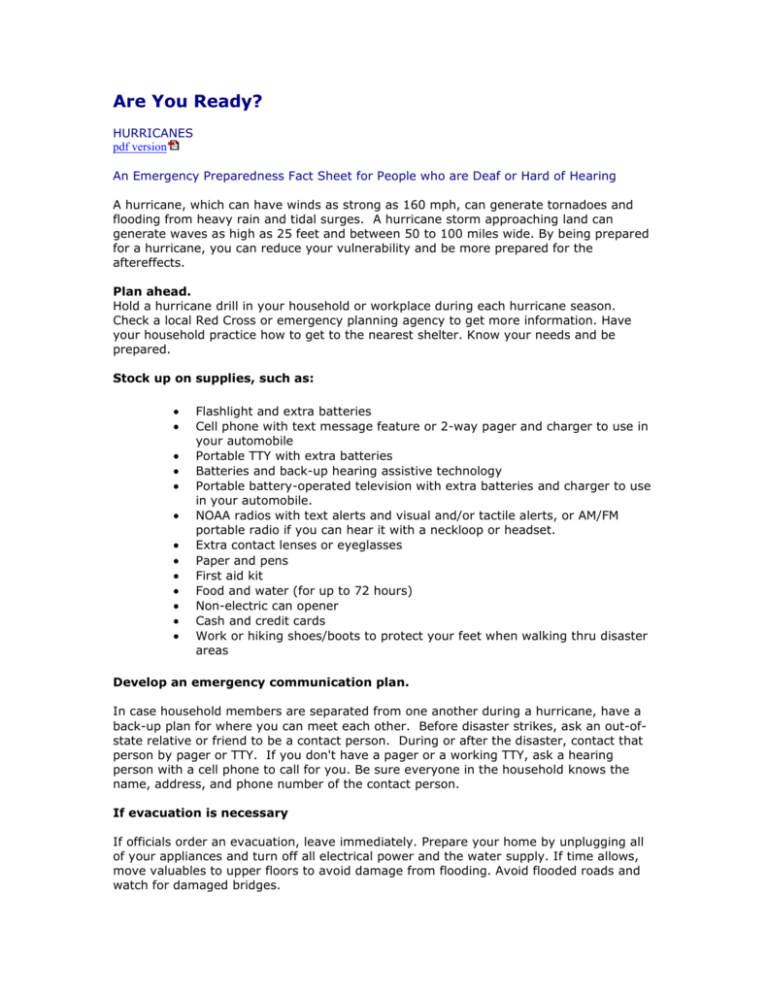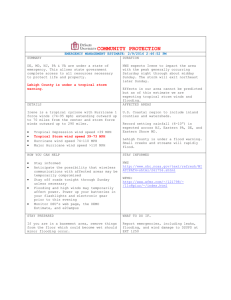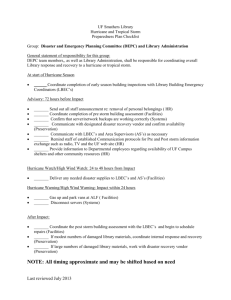
Are You Ready?
HURRICANES
pdf version
An Emergency Preparedness Fact Sheet for People who are Deaf or Hard of Hearing
A hurricane, which can have winds as strong as 160 mph, can generate tornadoes and
flooding from heavy rain and tidal surges. A hurricane storm approaching land can
generate waves as high as 25 feet and between 50 to 100 miles wide. By being prepared
for a hurricane, you can reduce your vulnerability and be more prepared for the
aftereffects.
Plan ahead.
Hold a hurricane drill in your household or workplace during each hurricane season.
Check a local Red Cross or emergency planning agency to get more information. Have
your household practice how to get to the nearest shelter. Know your needs and be
prepared.
Stock up on supplies, such as:
Flashlight and extra batteries
Cell phone with text message feature or 2-way pager and charger to use in
your automobile
Portable TTY with extra batteries
Batteries and back-up hearing assistive technology
Portable battery-operated television with extra batteries and charger to use
in your automobile.
NOAA radios with text alerts and visual and/or tactile alerts, or AM/FM
portable radio if you can hear it with a neckloop or headset.
Extra contact lenses or eyeglasses
Paper and pens
First aid kit
Food and water (for up to 72 hours)
Non-electric can opener
Cash and credit cards
Work or hiking shoes/boots to protect your feet when walking thru disaster
areas
Develop an emergency communication plan.
In case household members are separated from one another during a hurricane, have a
back-up plan for where you can meet each other. Before disaster strikes, ask an out-ofstate relative or friend to be a contact person. During or after the disaster, contact that
person by pager or TTY. If you don't have a pager or a working TTY, ask a hearing
person with a cell phone to call for you. Be sure everyone in the household knows the
name, address, and phone number of the contact person.
If evacuation is necessary
If officials order an evacuation, leave immediately. Prepare your home by unplugging all
of your appliances and turn off all electrical power and the water supply. If time allows,
move valuables to upper floors to avoid damage from flooding. Avoid flooded roads and
watch for damaged bridges.
Be alert for these watches and warnings:
Hurricane/Tropical Storm Watch: Hurricane/tropical storm conditions are possible in
specific areas.
Hurricane/Tropical Storm Warning: Hurricane/tropical conditions are expected in specific
areas, usually within 24 hours. Be alert for changes in the weather.
Hurricane terms and what they mean:
Advisory: Hurricane and storm information is distributed to the public every
six hours.
Special Advisory: Information is distributed when there are important
changes in storm-related weather conditions.
Gale Warning: Continued winds of 35-54 mph and strong wave action are
expected.
Tropical Disturbance: A moving area of thunderstorms in the tropics.
Tropical Depression: An area of low pressure turning circulation of clouds
and winds up to 38 mph is recognized.
Tropical Storm: A storm set apart by counterclockwise circulation of clouds
and 39-73 mph winds is developing.
What to do if a watch or warning is issued:
Watch television if closed captioning is available. Check the Internet or your pager for
hurricane reports. If no warning information is accessible, call the local television station,
Red Cross emergency shelter or a family member or friend. If this still is not helpful, go
to the nearest shelter to get information. Follow instructions if ordered to leave your
location.
Check your emergency supplies. Store drinking water in clean bathtubs,
jugs, bottles and cooking utensils.
Outdoor lawn furniture, toys and garden tools should be brought inside to
avoid harming people. Remove outdoor antennas if it is safe and possible to
do so.
Secure your home by installing hurricane shutters or precut plywood over
windows.
Put the refrigerator and freezer on the coldest settings, unless officials tell
you to turn off all electrical power.
Make sure your car's gas tank is filled. Review the evacuation route and get
your emergency supplies ready.
Put important papers in a waterproof container. If you have a boat, tie it up
or move it to a safe place.
After the hurricane:
When it is okay to go home, watch out for loose or downed power lines on your way
home.
Enter your home carefully. Open all windows and doors to dry out your home. Do not use
candles or open flames in the house in case there is a gas leak; use a flashlight instead.
Check for gas leaks. If you smell gas, leave the building immediately and leave the door
open. Call, or ask someone to call, the gas company.
Look for electrical damage. If you see sparks, turn off the electricity at the main fuse box.
If the area is flooded, call a licensed electrician.
Information adapted from materials by the Federal Emergency Management Agency
(www.fema.gov).
Category
Wind
Speed
Damage
Tidal
Surge
1
74-95
mph
Minimal (unanchored mobile homes,
vegetation and signs)
4-5 feet
2
96-110
mph
Moderate (all mobile homes, roofs, small
crafts, flooding)
6-8 feet
3
111-130
mph
Extensive (small buildings, low-lying roads
cut off)
9-12
feet
4
131-155
mph
Extreme (roofs destroyed, trees down,
roads cut off, mobile homes destroyed,
and beach homes flooded)
13-18
feet
Information adapted from materials by the Federal Emergency Management Agency
(www.fema.gov).
Questions? Comments? Contact the CEPIN Project at:
TDI, 8630 Fenton St. Suite 604, Silver Spring, MD 20910-3822
(301) 589-3006 TTY, (301) 589-3786 Voice, (301) 589-3797 Fax
www.tdi-online.org
· info@tdi-online.org
Or contact one of our regional centers:
CSD of Oklahoma: www.c-s-d.org
DCARA: www.dcara.org
DEAF, Inc.: www.deafinconline.org
NVRC: www.nvrc.org
This project was supported by Cooperative Agreement Number 2004-GT-T4-K008
administered by the U.S. Department of Homeland Security, Office of State and Local
Government Coordination and Preparedness. Points of views or opinions in this document
are those of the author and do not represent the official position or policies of the U.S.
Department of Homeland Security.
The CEPIN Project is coordinated by TDI and supported by by Cooperative Agreement Number 2004-GT-T4-K008
administered by the U.S. Department of Homeland Security, Office of Grants and Training. Points of views or
opinions in this document are those of the author and do not represent the official position or policies of the U.S.
Department of Homeland Security.
Copyright © 2006 CEPIN. All Rights Reserved.
Site design by Handsplash Creative Group.







